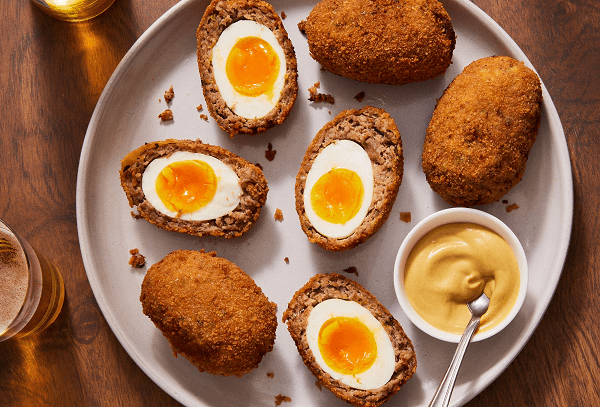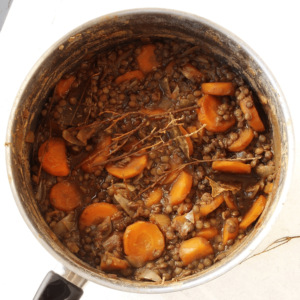Scotch eggs- Scotch eggs are a popular British dish that consists of a whole soft or hard-boiled egg wrapped in sausage meat, coated in breadcrumbs, and then deep-fried or baked until crispy. They are often served cold, making them a convenient and tasty snack or picnic food.
Here’s a basic recipe for making Scotch eggs:
Ingredients:
- Eggs (hard-boiled)
- Sausage meat (you can use pork sausage or any other preferred sausage meat)
- Breadcrumbs
- Flour (for coating)
- Salt and pepper (to taste)
- Optional: herbs and spices for added flavor
Instructions:
- Prepare the eggs:
- Hard-boil the eggs and let them cool. Peel the eggs carefully.
- Season the sausage meat:
- In a bowl, mix the sausage meat with salt, pepper, and any other desired herbs or spices.
- Wrap the eggs:
- Take a portion of the seasoned sausage meat and flatten it in your hand.
- Place a peeled hard-boiled egg in the center and wrap the sausage meat around it, ensuring the egg is completely covered.
- Coat in flour, egg, and breadcrumbs:
- Roll the sausage-covered egg in flour to help the egg stick.
- Dip it in beaten egg to coat.
- Roll it in breadcrumbs until fully covered.
- Cooking:
- You can either deep-fry the Scotch eggs until golden brown or bake them in the oven until the sausage is cooked through and the breadcrumbs are crispy.
- Serve:
- Let the Scotch eggs cool before slicing and serving.
Scotch eggs are versatile, and you can experiment with different types of sausage or add herbs and spices to customize the flavor. They are often enjoyed on their own, but you can also serve them with various sauces or condiments.
What is Scotch eggs
Scotch eggs are a popular British dish that typically consists of a whole soft or hard-boiled egg wrapped in sausage meat, coated in breadcrumbs, and then deep-fried or baked until crispy. The dish is believed to have originated in London, although its exact origin is a matter of debate.
The preparation involves encasing a boiled egg in sausage meat, which is then coated in flour, dipped in beaten eggs, and covered in breadcrumbs. This creates a crispy outer layer when the Scotch egg is cooked.
Scotch eggs are often served cold, making them a convenient and portable snack. They are commonly found in picnics, buffets, and as pub food. In recent years, variations of Scotch eggs have become popular, with some recipes incorporating different types of sausage, adding herbs or spices to the sausage meat, or even serving them with sauces or dips.
Who is Required Scotch eggs
Scotch eggs are a type of dish, not a person. It’s a popular British food item consisting of a whole soft or hard-boiled egg wrapped in sausage meat, coated in breadcrumbs, and then deep-fried or baked. The dish is believed to have originated in London, and it has become a classic part of British cuisine. Scotch eggs are often served cold and are enjoyed as a snack, picnic food, or pub snack. There’s no specific individual named Scotch eggs; it’s the name of the food item.
When is Required Scotch eggs

Scotch eggs are not associated with a specific time or occasion; rather, they are a type of food that can be enjoyed at various times. Scotch eggs are versatile and can be served as a snack, appetizer, or part of a meal. They are commonly found in picnics, buffets, and pub menus. People often enjoy Scotch eggs cold, making them convenient for picnics or as a portable snack.
So, there’s no specific time designated for Scotch eggs. They can be eaten whenever you have a craving for this delicious dish!
Where is Required Scotch eggs
Scotch eggs are a popular dish that originated in the United Kingdom, but they are not confined to any specific location. You can find Scotch eggs in various places where food is served. Here are some common locations where you might find Scotch eggs:
- Pubs and Restaurants: Many pubs and restaurants, especially those with a British or pub-style menu, serve Scotch eggs as an appetizer or snack.
- Cafes and Bakeries: Some cafes and bakeries may offer Scotch eggs as part of their menu, especially in regions where this dish is popular.
- Grocery Stores: In some places, you can find pre-packaged or freshly made Scotch eggs in the deli or prepared foods section of grocery stores.
- Specialty Food Shops: Specialty or gourmet food stores may also carry Scotch eggs, particularly if they offer a selection of prepared or international foods.
- Homemade: Scotch eggs are relatively easy to make at home, so many people prepare them in their own kitchens.
If you’re interested in trying Scotch eggs, you might want to check local eateries with a British influence or explore recipes to make them at home.
How is Required Scotch eggs
“Required Scotch eggs” doesn’t provide specific information about a particular preparation or method for Scotch eggs. However, if you are asking about how Scotch eggs are typically made, I can provide a general overview:
Ingredients:
- Eggs (hard-boiled)
- Sausage meat (pork sausage or another preferred sausage)
- Breadcrumbs
- Flour (for coating)
- Salt and pepper (to taste)
- Optional: herbs and spices for added flavor
Instructions:
- Prepare the eggs:
- Hard-boil the eggs and let them cool. Peel the eggs carefully.
- Season the sausage meat:
- In a bowl, mix the sausage meat with salt, pepper, and any other desired herbs or spices.
- Wrap the eggs:
- Take a portion of the seasoned sausage meat and flatten it in your hand.
- Place a peeled hard-boiled egg in the center and wrap the sausage meat around it, ensuring the egg is completely covered.
- Coat in flour, egg, and breadcrumbs:
- Roll the sausage-covered egg in flour to help the egg stick.
- Dip it in beaten egg to coat.
- Roll it in breadcrumbs until fully covered.
- Cooking:
- You can either deep-fry the Scotch eggs until golden brown or bake them in the oven until the sausage is cooked through and the breadcrumbs are crispy.
- Serve:
- Let the Scotch eggs cool before slicing and serving.
This is a basic recipe, and there are many variations and creative twists you can explore based on personal preferences.
Case Study on Scotch eggs
While I can’t provide real-time or specific case studies, I can outline how a hypothetical case study on Scotch eggs might look. A case study could focus on various aspects, including the history, market trends, consumer preferences, or business strategies related to Scotch eggs.
Title: “Exploring Trends and Challenges in the Scotch Eggs Market: A Case Study”
Introduction: Provide background information on Scotch eggs, their origin, and their popularity as a traditional British dish. Highlight the recent surge in interest and demand for Scotch eggs, both domestically and internationally.
Objectives:
- Examine the historical development of Scotch eggs and their cultural significance.
- Analyze current market trends and consumer preferences related to Scotch eggs.
- Evaluate challenges and opportunities for businesses involved in the production and sale of Scotch eggs.
Methodology:
- Historical Analysis:
- Explore the origins of Scotch eggs and how they have evolved over time.
- Investigate cultural and regional variations in the preparation and consumption of Scotch eggs.
- Market Trends:
- Conduct surveys or interviews with consumers to understand their preferences regarding Scotch eggs.
- Analyze market data to identify current trends, including variations in recipes, packaging, and marketing strategies.
- Business Strategies:
- Interview businesses involved in the production and sale of Scotch eggs to understand their marketing and production strategies.
- Evaluate the impact of factors such as health trends, dietary preferences, and the demand for convenience on the Scotch eggs market.
Results:
- Historical Insights:
- Scotch eggs have a rich history dating back to the 18th century, with regional variations in ingredients and preparation methods.
- Cultural shifts and globalization have contributed to the popularity of Scotch eggs beyond the UK.
- Market Trends:
- Increased demand for high-quality, gourmet Scotch eggs with diverse fillings (e.g., black pudding, chorizo).
- Growing interest in healthier versions, such as baked or air-fried Scotch eggs.
- Business Strategies:
- Successful businesses have embraced innovation by introducing unique flavors and marketing Scotch eggs as a versatile and convenient snack.
- Some businesses have adapted their recipes to cater to specific dietary preferences, such as gluten-free or vegetarian options.
Challenges and Opportunities:
- Challenges:
- Addressing concerns about the nutritional content and health implications of deep-fried Scotch eggs.
- Navigating market competition and differentiation in an increasingly diverse market.
- Opportunities:
- Capitalizing on the trend toward premium and artisanal food products.
- Exploring international markets and adapting Scotch eggs to suit different culinary preferences.
Conclusion: Summarize the key findings from the case study, emphasizing the dynamic nature of the Scotch eggs market and the need for businesses to adapt to changing consumer preferences and market trends.
Remember, this is a hypothetical case study outline, and actual case studies would require more in-depth research, data collection, and analysis.
White paper on Scotch eggs
A Culinary Exploration
Executive Summary:
Scotch eggs, a classic British dish, have evolved from their humble origins into a versatile and beloved culinary creation. This white paper explores the historical roots, cultural significance, and contemporary trends surrounding Scotch eggs. We delve into the ingredients, preparation methods, and the dynamic market landscape, offering insights for both consumers and businesses involved in the Scotch eggs industry.
Table of Contents:
- Introduction:
- Brief overview of Scotch eggs and their popularity.
- Importance of Scotch eggs in British culinary history.
- Historical Evolution:
- Tracing the origins of Scotch eggs back to their introduction in the 18th century.
- Regional variations and cultural influences shaping Scotch eggs over time.
- Ingredients and Preparation:
- Examination of the core components: eggs, sausage meat, breadcrumbs, and spices.
- Traditional vs. modern approaches in preparing Scotch eggs.
- Exploring unique variations, such as vegetarian or gourmet renditions.
- Cultural Significance:
- Scotch eggs in British traditions, including picnics, pub fare, and celebrations.
- Impact of globalization on Scotch eggs’ popularity beyond the UK.
- Market Trends:
- Current market analysis, including growth trends and consumer preferences.
- Emerging variations and flavors to meet diverse tastes.
- Health-conscious adaptations, such as baked or gluten-free options.
- Business Landscape:
- Profiles of key players in the Scotch eggs industry.
- Successful marketing and branding strategies.
- Challenges and opportunities faced by businesses.
- Consumer Preferences:
- Insights from surveys and interviews on what consumers look for in Scotch eggs.
- The influence of social and cultural factors on purchasing decisions.
- Health and Nutrition:
- Nutritional aspects of Scotch eggs and considerations for health-conscious consumers.
- Exploring potential modifications to enhance the nutritional profile.
- Internationalization:
- Scotch eggs in the global market.
- Adaptations and variations to suit different cultural palates.
- Conclusion:
- Summarizing key findings and insights.
- Predictions for the future of Scotch eggs in the culinary landscape.
Conclusion:
Scotch eggs, with their rich history and adaptability, continue to capture the culinary imagination. This white paper aims to provide a comprehensive understanding of Scotch eggs, from their historical roots to their current status in the dynamic food industry. Whether you are a consumer looking to explore diverse flavors or a business seeking opportunities in the market, this exploration of Scotch eggs offers valuable insights into a dish that has stood the test of time.
Industrial Application of Scotch eggs
While Scotch eggs are traditionally a food item enjoyed in the culinary world, they don’t have direct industrial applications in the traditional sense. Scotch eggs are typically produced on a smaller scale, often by restaurants, pubs, or food manufacturers specializing in prepared or deli foods.
However, we can explore creative and hypothetical scenarios where elements inspired by Scotch eggs could be used in an industrial context:
- Food Manufacturing:
- Mass Production for Retail: A food manufacturer could develop a streamlined process for mass-producing Scotch eggs to meet the demand for convenient, ready-to-eat snacks in retail settings.
- Automated Assembly Lines: Implementing automated assembly lines for the preparation of Scotch eggs, where each component (boiled eggs, sausage meat, breadcrumbs) is processed and assembled efficiently.
- Culinary Innovation:
- Frozen or Refrigerated Products: Industrial food companies could produce and distribute frozen or refrigerated Scotch egg products, providing consumers with a convenient and consistent option for quick meals.
- Variety in Fillings: Exploring industrial-scale production of Scotch eggs with a wide range of fillings to cater to diverse consumer tastes.
- Catering and Events:
- Large-Scale Events: An industrial approach to preparing Scotch eggs could involve creating large quantities for catering at events, conferences, or parties.
- Customization for Events: Offering customization options for event organizers, such as themed or branded Scotch eggs.
- Health and Convenience:
- Health-Conscious Variants: Developing and producing healthier variants of Scotch eggs, such as low-fat sausage meat or using alternative coatings, to cater to health-conscious consumers.
- Packaging Innovation: Designing packaging solutions that maintain the integrity and freshness of Scotch eggs for extended periods, suitable for large-scale distribution.
It’s important to note that while these ideas involve an industrial scale of production, they are still within the realm of the food industry and not necessarily in broader industrial applications. The core concept of Scotch eggs remains rooted in culinary traditions and gastronomy.





